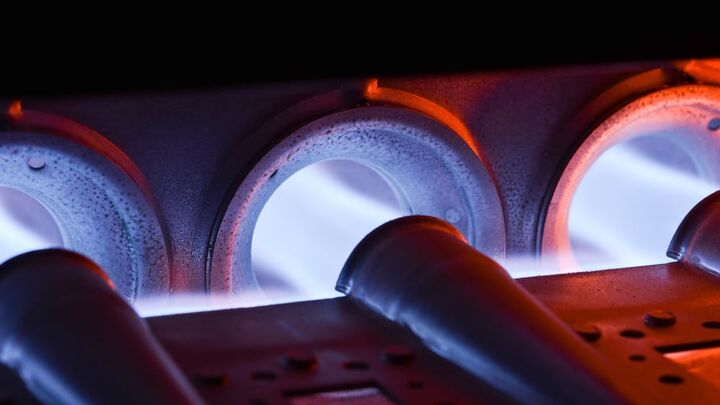Furnace Flame Goes Out When The Blower Comes On? (We Have A Fix)

When it is working properly, your furnace is capable of making your home comfortable in even the coldest of temperatures. The process requires several components coming together at once to produce warm air that blows throughout your home.
A furnace flame can go out when the blower turns on if the flame rollout switch is worn or the sensor is dirty. The blower can also make the furnace flame go out if there is a problem with the control board. Poor gas pressure can produce a weak flame that can easily go out when the blower runs.
Do You Need a Furnace Repair Contractor?
Get free, zero-commitment quotes from pro contractors near you.

What Does the Blower Do?
There are some components within your furnace that have complicated roles. Identifying what they do can help you to better understand not only their role but how to implement the proper repairs when the time comes.
The blower, however, is not one of those complicated parts. Its job is simple: blow hot air through your ducts and eventually into your home. The only thing to keep note of is that there is a blower motor and a blower fan that make the whole thing work. When one of those components is compromised, hot air may not be able to distribute through your home.
Flame Rollout Switch
There are two common causes that you should check first: the flame sensor and the flame rollout switch. If your furnace runs for a few minutes only to go off when the blower starts up, you could have a defective flame rollout switch.
- What it does. The flame rollout switch is responsible for monitoring the level of heat that surrounds the burners.
- Recognizing the problem. When the burners aren’t being drawn into the heat exchanger and the exhaust ends up expelling the flue, the rollout switch opens. When this happens, it can prevent the furnace from heating at all. Even if it starts up, it will stall out after some time.
When the rollout switch is not working right, there won’t be enough air flowing through the burner and the furnace won’t be able to heat properly when the blower kicks on.
Flame Sensor
If, after checking the flame rollout switch, you still haven’t found a solution the next likely culprit is the flame sensor. The flame sensor actually works in tandem with the flame rollout switch.
- What it does. The flame sensor is similar to the flame rollout switch, but the main difference is that it is responsible for monitoring the gas burner, not the heat surrounding the burners.
- Recognizing the problem. Should your furnace start but then shut off after the blower kicks on, it could be that the flame sensor is not recognizing the flame. When that happens, the control board will then shut the voltage off to the gas valve, thus cutting off the heat cycle.
Most of the time, you can remedy the situation by cleaning the flame sensor. If the issue persists, though, the flame sensor will likely need replacing. Try cleaning the flame sensor using some sort of soft abrasive pad so as to properly remove any buildup without scratching or damaging the sensor itself.
Control Board
This is probably one of those components that you don’t want to malfunction. After troubleshooting the two prior issues, it could be worth checking out the control board. The control board is responsible for regulating power to all of the various components of the furnace.
When the board stops working properly or fails to deliver the necessary voltage to the required components, there can be a failure in the board itself. When the board stops working the way it is meant to, the cycle may kick on and then off after short periods. The control board is fairly difficult to replace and will likely require professional intervention.
Pressure Switch
Another reason that your furnace may be running for just a few minutes before shutting off could be due to a defective pressure switch. Defective pressure switches usually can’t be repaired and will need to be replaced.
Normally, the draft inducer motor produces airflow that goes through the burner. The pressure switch should eventually close, indicating to the pressure board that there is accurate airflow so that the ignition process can move forward. When the switch is defective, it can pause or stop the ignition process.
Draft Inducer Motor
Continuing along on the troubleshooting path, you could be looking at a faulty draft inducer motor. If you’ve gotten this far down the line, you’re not likely to find the inducer motor at fault but crazier things have happened.
- What it does. The draft inducer fan motor is responsible for drawing air into the burner before that air gets “thrown out” into the outlet. That airflow into the burner is what causes the pressure switch to close as well, letting the board know that there is proper airflow.
- What’s wrong? When the draft inducer motor isn’t working properly or is entirely defective, the pressure switch won’t close. And when the pressure switch doesn’t close, the ignition process will stop, failing to warm the air that blows into your home.
The draft inducer motor can be a tricky fix. If you have prior HVAC experience, you may be able to perform the fix yourself but it’s probably better to have a professional perform the repairs.
Airflow Problems
There is a chance that your furnace could be running into airflow problems. When there are airflow problems, your furnace will kick on as normal before turning off again when the blower kicks on. Your furnace needs proper airflow going into the burner so that the burner can remain on. When there isn’t proper airflow, the furnace may not be able to trip the limit on the thermostat.
What you may not have realized is that the burner draws in air from right outside the home or from the area surrounding the home. Keeping the furnace in a cramped room like a utility closet or storage room may restrict the necessary air required for the furnace to work the right way.
In the event that your furnace draws air from outside, make sure that there is nothing blocking your air inlet. During the winter, in particular, there can be a buildup of ice that prevents air from flowing as it should.
Do You Need a Furnace Repair Contractor?
Get free, zero-commitment quotes from pro contractors near you.

How Does the Furnace Ignition System Work?
The ignition system is what begins the heating process right before the blower starts. There are different furnaces out there that have slight differences within their ignition systems, but the average ignition system works something like this:
- Thermostat. You punch in the temperature on the thermostat and the thermostat relays that information to the furnace, calling for heat.
- Draft inducer fan. With the orders in, the draft inducer fan then kicks on. The fan pulls fresh air into the furnace in order to create a combustion chamber that is safe for ignition.
- Gas valve. The next step in the process is the gas valve opening. Its job is to send the proper amount of gas to the pilot burner. Be aware that a faulty valve can remain open, leaving a buildup of gas within your system that can be potentially dangerous.
- Pilot light. Now that there is gas ready to be lit, the pilot light takes care of this through an electronic spark. The pilot light can be different based on what type of furnace you have (gas versus electric, for instance).
- Flame sensor. The flame sensor, as covered above, lets the furnace know that the pilot has been lit properly and safely. If the flame sensor is defective, it won’t detect properly, and the entire process can get interrupted.
- Burners. With the gas valves open, gas gets sent into the main burners. This is how the pilot light is lit.
- Blower. With the ignition process complete and the air warmed up to the proper level, the blower can then start to distribute that warm air into the vents and out into your home. Any interruption to the process can stop it before that air is distributed.

Ryan Womeldorf has more than a decade of experience writing. He loves to blog about construction, plumbing, and other home topics. Ryan also loves hockey and a lifelong Buffalo sports fan.
More by Ryan Womeldorf



























